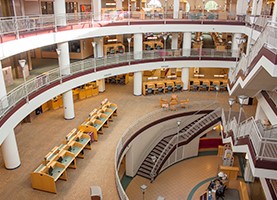A common theme in academic libraries over the past ten years has been the repurposing of space. Sections of libraries previously occupied by print book and journal collections, or previously used as individual study areas, have been transformed into new spaces for student collaborative study and student academic support services.
The primary driver of this change has been the transition from print to electronic publishing. Journals and books, which in the past were available only in print format, can now be purchased in electronic versions, and in some cases only in electronic versions.
Every year, libraries are devoting a greater percentage of their collections budgets to the purchase of electronic resources. Libraries are also removing significant amounts of their existing print journal collections as digitized versions of these bound back issues become available. Since the back issues of some journals can run to hundreds of volumes, this has been a way to free up significant amounts of space. Libraries are also replacing their microfilm and microfiche back issues with electronic equivalents. While print books and journals won’t entirely disappear from library shelves any time soon, every library is seeing an increasing percentage of its collections moving into electronic formats, making the space formerly used to house print collections available for other uses.
Electronic books and journals present distinct advantages for libraries. From the staff point of view:
• E-resources are accessible immediately upon purchase. There is no waiting for them to be shipped to the library.
• They require less processing time since there’s no need to unbox, stamp, and label the items.
• They don’t require the maintenance of print books, such as reshelving or re-binding.
The advantages to library users are even more compelling:
• E-books and e-journals are available to researchers 24 hours a day, 7 days a week. Access to library materials is no longer limited to the library’s hours of operation.
• These materials are accessible from anywhere, at the convenience of the user. Students can complete research from a residence hall room, a classroom, a coffee shop, or wherever they happen to be.
• Saving, printing, or emailing an electronic article or book chapter, or simply cutting and pasting a small portion, is easily done.
• E-books and journal platforms offer a robust search function, which is an improvement on the indexes available in print items.
Another driver of this transformation is the change in student learning. In the 21st century there is less emphasis on the traditional research paper and individual work and more on group learning and collaborative projects. Students need a place to gather with their classmates to work on projects, case studies, and presentations. The CMU Libraries regularly surveys its student users and one of the things we’ve heard over the years is requests for more spaces where groups can meet and work. To keep up with students’ changing study habits, libraries are creating more open, multi-functional, and collaborative spaces within their buildings.
The decrease in square footage devoted to physical materials has allowed libraries to share their buildings with academic support units not traditionally associated with the library, such as writing centers, tutoring services, presentation skills centers, and data visualization labs. The academic library of the 21st century is so much more than a collection of materials and a place to study. It is a hub of student learning, a place where students can do research, collaborate, get help with an assignment, meet friends, learn new skills, and create new materials. On many campuses, the university library is centrally located and heavily used by students. Because of this, institutions are deliberately placing student support services in the convenient, attractive, and flexible library building.
The CMU Libraries will continue to review and update its spaces in order to create the best possible Park Library for CMU students, faculty, and staff.

